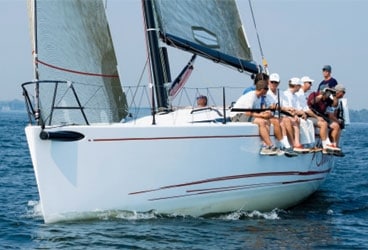
ClubSwan368
Before there was a Club Swan 42 there was a concept. David Elwell, of the New York YC, wanted to develop a one design capable of participating in yacht club cruises, regattas, and offshore events such as the Bermuda Race. Elwell and other members of the club also wanted the design to be competitive under IRC. After many meetings and proposals from several designers and builders, NYYC members-and anyone else willing to pony up the deposit and get in the long line of prospective owners-have created a high-performing, no-nonsense raceboat that’s already begun to make a mark on the U.S. racing scene. Much to the chagrin of Swan 45 owners, the CS42 is, by all reports, a faster boat, and has already proven to be more popular, with 47 sold in the United States this year. The Club Swan looks good, and it does so because of experience of its designer and the expense of putting in touches like the halyards and mainsheet that are led underneath the deck. The cockpit is ergonomic and comfortable. The spar package, a carbon-fiber mast and sprit, and an aluminum boom, is by Hall Spars. Deck hardware is entirely Harken and all leads and sail controls worked well. With twin wheels, getting around the helm was easy, as was viewing the tell tales on the jib. In light air the boat showed a good turn of speed. It sailed upwind very easily and excelled downwind. The 26.63 sail-area-to-displacement ratio explains why it does so well in light air, and although we sailed it in a 6-knot breeze, it required maximum crew weight on the rail [the one-design class maximum crew weight is 1,870 pounds]. The hull and deck are resin infused with a foam core. There’s a portion of the transom in the lazarette that’s not painted with gelcoat, and the only thing you can see is core. In lesser boats you’d see the glass and not the core. This is an indication that the glass has been completely impregnated and has an average glass-to-resin ratio of 60-to-40 percent or better. This is a great way to build a one-design production boat and ensures one-design tolerances, boat after boat. The laminate is also tougher and has better impact resistance compared to laminate that isn’t infused. The boat has a solid glass grid structure, which should make it much easier to repair in the event of a grounding than if it had a metal grid structure, which might bend or buckle under extreme loads. The glass frame should elevate the resale value of any boat. While I wasn’t able to inspect the keel bolts and immediate glass structure because of the salon table, batteries, and mast jack, the rest of the bilge structure was clean and looked as if it would be easier to take care than a boat without a sump. Nautor builds the CS42 in Estonia, and because it’s a new facility, they’re building boats differently (more high-tech) than they are in Finland. One might expect teething problems and there have been some. By all accounts, however, Nautor’s Swan has aggressively addressed any early build and warranty issues.The CS42’s interior is simple, but clean in its design. You can read this as saying the boat has a standard layout that is functional for its intended purpose. There was some debate among the judges whether the quality was as good as older Swans. The workmanship was still there, but the CS42 is a much different boat from previous Swans, with a far more Spartan interior that’s intended for the rigors of distance and buoy racing.With aft cabins port and starboard, each with pipe berths, the CS42 has offshore racing in its future. The V-berth is large and can be taken off the boat for day racing. With the V-berth in place there is a ton of storage, if the boat is ever to be cruised. You might not care how nice the head is, but there, and throughout the boat for that matter, many of the little finish touches are better quality than in many other boats we looked at. There are custom stainless fittings, stainless fuel lines and returns, engine access, and a headliner that allows easier access to deck hardware. Originally, the NYYC group wanted to have a boat on the starting line for about $500,000, but we were told that the base price is $550,000 with most boats getting to the starting line for about $750,000 to $800,000. Keep in mind, though, that sail buttons are severely limited, at three new sails a year, and that no professionals can be paid to race in class events.This is pricey for a racer/cruiser this size, but, the sailing capabilites, layout, overall construction, and finish will make this boat very much a force on the international playing field. And with the CS42’s larger size and quality of build, an argument could be made that its base price is reasonable. What may make the boat most appealing for racers is the fact that, with so many already sold, the racing should be excellent.
For SW‘s complete 2008 Boat of the Year coverage, click here









